Eye color varies dramatically in owls. It can range from black, brown, orange, yellow, to green, and some other variations. The color of an owl’s eyes depends on the pigments and light refraction, just like the color of their plumage.
According to a 2018 study, most nocturnal owls have dark eyes, while those that hunt during the daytime are with yellow or orange ones. There are, of course, lots of exceptions to this rule.
Examples of owls with black eyes include the barn owl, barred owl, Himalayan owl, lesser sooty owl, and many others.
In this article, you will learn what each of these looks like and how to best identify them in nature.
Table of Contents
Owls With Black Eyes
1. Barn Owl
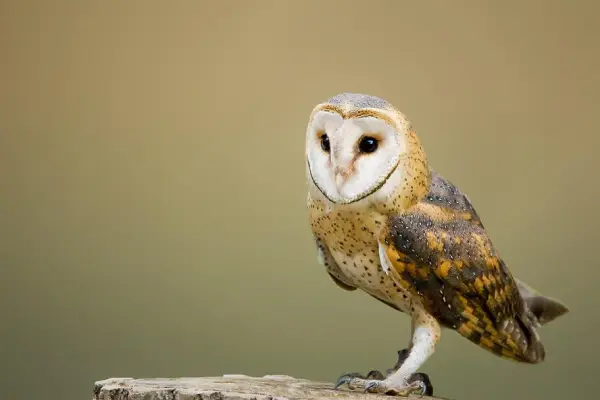
- Scientific Name: Tyto alba
- Length: 13-15 in
- Weight: 9-19 oz
One of the most widely distributed species of owl in the world, barn owls are highly elusive raptors found around open fields, riparian areas, and farms.
These medium-sized owls have a “ghostly” appearance due to their heart-shaped heads, mottled brown-gray upperparts, and underparts that vary from white to brown.
Barn owls also have pitch-black eyes with a large binocular field of view – the axial length (from front to the back of the eye) of their eyes is about 3/4 of that of human eyes (0.68 in vs. 0.96 in).
These owls will often perch on branches, fence posts, or other lookouts and scan their surroundings. Barn owls do not hoot and make bone-chilling screams instead.
They hunt for rodents during the night and roost in nest boxes, caves, tree hollows, and old buildings. The species are monogamous and stay together for life – barn owls will have a clutch size of two to eighteen eggs that females incubate while males feed them.
They are quite common in the USA and can be seen together with other birds in southern California, northern California, east Tennessee, west Washington, etc.
2. Lesser Sooty Owl
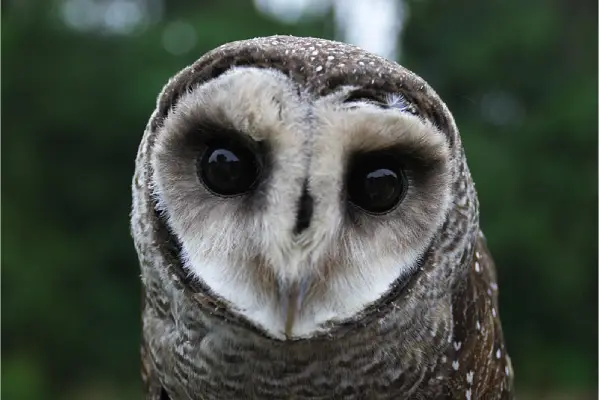
- Scientific Name: Tyto multipunctata
- Length: 13-15 in
- Weight: 0.94-1.12 lb
Lesser sooty owls are strictly nocturnal birds with black eyes. They are found in the wet tropical regions of Australia where they hunt on bandicoots, rats, birds, and squirrel gliders.
Lesser sooty owls spend most of their day hiding in dense foliage and hunt around roads, clearings, and inside forests they inhabit during the night.
These dark-eyed birds play an important role in the ecosystem as they keep down rodent populations. Similar to other birds of prey, females are larger than males and measure a few inches longer.
Lesser sooty owls have black or dark gray plumage with white speckles, heart-shaped faces (just like barn owls), and grayish-brown beaks. Their breeding season depends on the rain but mostly lasts from January to August. Pairs get most noisy when the breeding season starts, often making high-pitched whistles and different trills and chirrups.
3. Spotted Owl
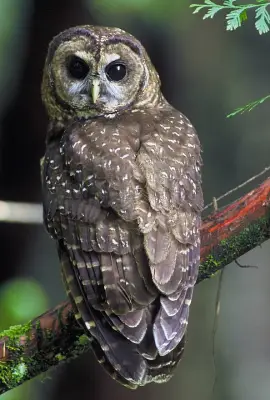
- Scientific Name: Strix occidentalis
- Length: 17 in
- Weight: 1.3 lb
Spotted owls are species of true owls. True owls or typical owls belong to the Strigidae family and are one of the two generally accepted owl families, together with barn owls.
These nocturnal birds are found in western parts of North America. There are 3 subspecies:
- Northern spotted owl (S. o. caurina)
- Mexican spotted owl (S. o. lucida)
- California spotted owl (S. o. occidentalis)
They prefer the coolest parts of the forest, nesting at cliffs ranging from 5,000 to 7,000 feet. Identify spotted owls by their chestnut brown plumage with white and brown spots, white bands on the tails, and dark eyes.
The species hunt at night, jumping from one tree to another in pursuit of prey. Their diet includes insects, birds, pocket gophers, mice, and woodrats.
Due to habitat loss and competition with other owls, their population has been on the decline – the International Union for Conservation of Nature (IUCN) listed spotted owls as Near Threatened.
4. Spot-bellied Eagle-Owl
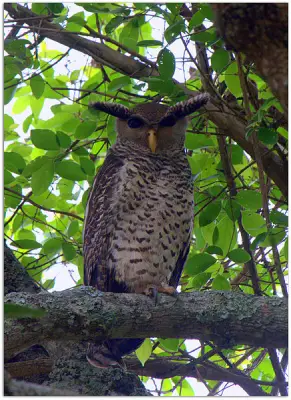
- Scientific Name: Bubo nipalensis
- Length: 20-26 in
- Weight: 3.3-5.5 lb
Also known as forest eagle-owls, these large birds of prey are found in Asia. They live in dense wet lowland and hill forests.
Spot-bellied eagle owls are the sixth longest owls in the world, reaching 26 inches in length. They have grayish-brown plumage, large yellow beaks, black eyes, and almost horizontal ear tufts. They will make deep echoing hoots to communicate.
These owls are nocturnal and will spend most of the day hidden in dense foliage; occasionally they might hunt during the day. Spot-bellied eagle owls hunt on pheasants, peafowl, junglefowl, lizards, fish, and even large prey like jackals and small deer.
5. Barred Owl
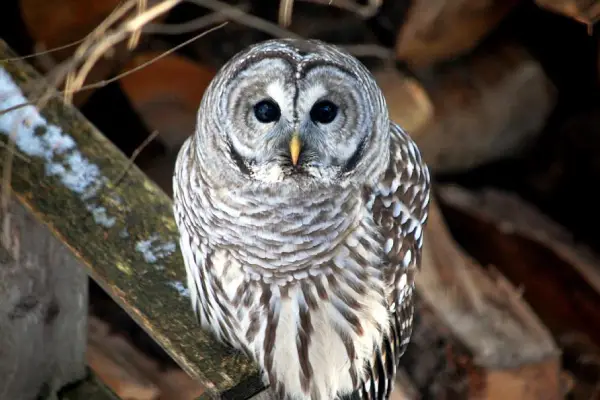
- Scientific Name: Strix varia
- Length: 16-25 in
- Weight: 1.3-2.5 lb
Known under several names (northern barred owls, striped owls, or more informally, hoot owls), barred owls are large birds with mottled brown and white plumage.
They can be identified by their yellow beaks, absence of ear tufts, and hoots that sound like “who cooks for you, who cooks for you all” and that can be heard almost half a mile away.
Barred owls also have large and dark brown, almost black eyes. They are native to eastern North America and are found mostly around woods and swamps where they hunt for insects, small mammals, crayfish, and crabs.
Barred owls will nest in tree holes or use abandoned nests of other animals, from red-tailed hawks to squirrels. After they establish nests, barred owls become very territorial and aggressive – they will chase away intruders by hooting aggressively or attacking them with their sharp talons!
6. Himalayan Owl

- Scientific Name: Strix nivicolum
- Length: 14.7 in
- Weight: 0.84 lb
Himalayan owls are also known as Himalayan wood owls. These raptors were once considered to be subspecies of tawny owls but differ from them by their darker color, shorted tails, and distinctive calls.
They will often emit repeated hoots. Himalayan owls live in the forests of Asia, ranging from the Himalayas to Eastern China and Taiwan. These medium-sized owls have rounded heads, no ear tufts, brown plumage, and deep black eyes.
Himalayan owls mostly feed on insects, rodents, and birds. They are monogamous and breed mostly from December to April.
7. Tawny Owl
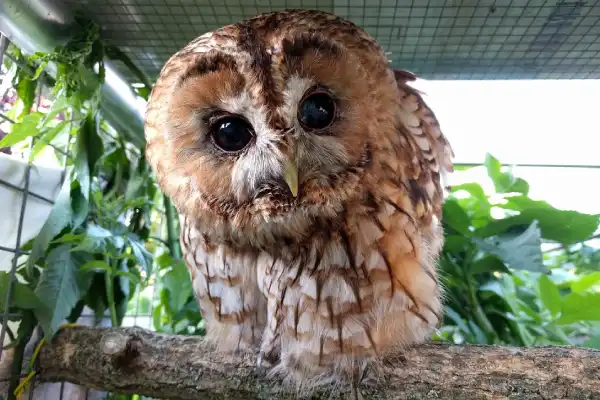
- Scientific Name: Strix aluco
- Length: 15-18 in
- Weight: 0.8-1.7 lb
Tawny owls are also known as brown owls and can be found in Europe and Asia. These stocky raptors with jet black eyes, rounded heads, no ear tufts, and dark facial disks come in two colors: one is rufous-brown and the other is grayish-brown.
Brown owls are dimorphic species where females are longer and heavier than males. Thanks to their good vision, keen sense of hearing, and ability to fly silently, these nocturnal animals hunt with ease.
Their most common prey are rodents, although they might also feed on birds, rabbits, and insects – they swallow them whole and regurgitate indigestible parts as pellets later. Tawny owls are very territorial species and when young birds leave the nests, if they can’t find a territory to claim of their own, they will often die of starvation.
Due to their activity at night and haunting “hooo” calls, people consider them to be an omen of bad luck.
8. Greater Sooty Owl
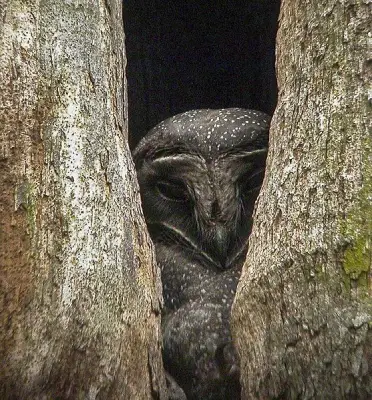
- Scientific Name: Tyto tenebricosa
- Length: 14.6-20 in
- Weight: 1.1-2.6 lb
Greater sooty owls are medium-sized dark-gray owls found in Australia and New Guinea. These elusive birds have large dark eyes that are set in a round large facial disk and white speckles on their plumage.
Greater sooty owls live around rainforests and wet eucalypt forests where they keep their territories and feed on marsupials, rodents, birds, bats, and insects. These owls have rather large eyes which might indicate that they rely a lot on vision when hunting. They are strictly nocturnal and communicate using a range of rasps, screams, and distinct “falling bomb” whistles.
9. Ural Owl

- Scientific Name: Strix uralensis
- Length: 19.7-24.4 in
- Weight: 1-3.2 lb
Ural owls are found from Scandinavia in Europe all the way to Japan. These large owls can be identified by their small dark eyes, bright yellow beaks, pale gray to dark brown plumage, and lack of ear tufts.
Ural owls inhabit deciduous or mixed forests and woodlands with clearings where they feed on voles, shrews, rats, mice, birds, insects, and lizards. They are nocturnal and hunt at night, detecting their prey by sound.
Ural owls are monogamous and stay together for years, often for life. To strengthen their bond, males will sing and provide prey to females. Males also make deep, resonating hoots while the females emit higher, hoarser notes.
What would owls look like if they had blue eyes?: 10 Unique Owls With Black Eyes (+Photos!)10. Flammulated Owl

- Scientific Name: Psiloscops flammeolus
- Length: 6 in
- Weight: 1.8-2.3 oz
Flammulated owls are unique among small owls due to their completely dark eyes. These tiny reddish birds are just 6 inches long and span around 14 inches across the wings – such large wings allow them to quickly move from one tree to the other.
Females are longer and bigger than males – the species were named after the flame-like markings on their faces. Flammulated owls are migratory birds found in western parts of the USA, southern parts of British Columbia, central Mexico, and Central America (during winter).
Strictly nocturnal, they almost entirely feed on insects and some shrews, and other rodents. Because of the long trachea (windpipe), flammulated owls can make low-pitched hoots that sound like much larger owls made them.
Summary
Owl eyes have captivated humans for centuries. Their eyes add to their overall beauty and help detect any movement before grabbing their prey – although they do not particularly help owls see better during the night, the dark color of their irises will camouflage them better than brighter-colored ones. Some examples of these birds include barn owls, barred owls, tawny owls, etc.